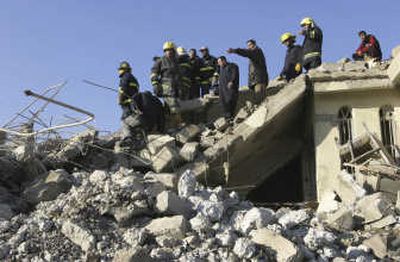Mosul blast may signal a greater al-Qaida role

BAGHDAD – The abandoned apartment block known as the Pepsi building vanished in seconds, leaving a 30-foot-deep blast crater and a ring of destruction for a quarter mile in every direction through a shanty district in Mosul.
Then on Thursday – even before the final death count was tallied – came more bloodshed: A suicide bomber killed a police chief and two other officers as they toured the devastation from the previous day. Residents with insurgent sympathies taunted the chief moments before the attack.
Two deadly days have underscored what some U.S. military commanders fear is ahead for the northern city: that al-Qaida in Iraq could be prepared to use all means of chaos and violence to defend its last urban redoubt.
The stakes are high on both sides.
Al-Qaida and its supporters would find themselves without a major base of operations if ousted from Iraq’s third-largest city, which occupies transport crossroads between Baghdad, Syria and other points. But a drawn-out fight could serve to rally insurgents and expose potential security weaknesses where U.S. troops are thin and Iraqi forces must take a front-line role.
“Mosul will continue to be a center of influence for, center of gravity for, al-Qaida,” U.S. military spokesman Rear Adm. Gregory Smith said earlier this week, calling it a hub for both insurgent financing and foreign fighters.
“The flow through Mosul is critical for al-Qaida in Iraq,” he added.
But Mosul only gained this role after extremists were put on the run.
Al-Qaida first started to lose its footholds in the western Anbar province after Sunni tribes turned against them and joined the U.S.-led fight. The military successes then began to pile up in Baghdad and other central regions – forcing many insurgents to seek new havens in the north.
The centerpiece of the shift is Mosul, about 225 miles northwest of Baghdad, where insurgents are believed to use the cover of sprawling sheep and produce markets to smuggle cash, weapons and foreign fighters from nearby Syria. With the northward migration, U.S. officers have sought – but not received – additional forces for Mosul.
They also see no immediate signs of a Sunni groundswell as in Anbar and other places. U.S. military envoys have shown little or no progress in efforts to form Mosul branches of the so-called Awakening Council movement.
Messages coming from the U.S. high command have been mixed.
Late last year, Army Col. Tony Thomas, deputy commander of U.S. forces in the north, appealed for more help. He told reporters traveling with Defense Secretary Robert Gates that officers would like more American troops in the north, as well as the return of 1,400 Iraqi troops who were sent to Baghdad as part of the military buildup last year.
There has been no known major shift of U.S. forces, however, partly because civilian deaths have declined – by nearly half from a year ago, according to an Associated Press count.
The No. 2 U.S. commander in Iraq, Lt. Gen. Ray Odierno, said last week that holding U.S. troop strength at current, lower levels in regions such as Mosul would serve as a “model” going forward.